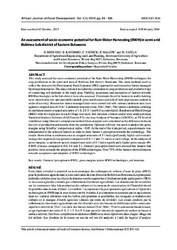| dc.contributor.author | Mpatane, O. | |
| dc.contributor.author | Kayombo, B. | |
| dc.contributor.author | Patrick, C. | |
| dc.contributor.author | Malope, P. | |
| dc.contributor.author | Tapela, M. | |
| dc.date.accessioned | 2023-02-15T09:43:05Z | |
| dc.date.available | 2023-02-15T09:43:05Z | |
| dc.date.issued | 2015-10-02 | |
| dc.identifier.citation | Mpatane, O., Kayombo, B., Patrick, C., Malope, P., & Tapela, M. (2016). An assessment of socio-economic potential for Rain Water Harvesting (RWH) in semi-arid Bobirwa Sub-district of Eastern Botswana. African Journal of Rural Development (AFJRD), 1(1978-2017-2068), 99-106. | en_US |
| dc.identifier.issn | 2415-2838 | |
| dc.identifier.uri | file:///C:/Users/tmetlhaleng/Downloads/Vol1Issue1%20(1).pdf | |
| dc.identifier.uri | https://hdl.handle.net/13049/630 | |
| dc.description | Journal Article | en_US |
| dc.description.abstract | This study assessed the socio-economic potential of the Rain Water Harvesting (RWH) techniques for crop production in the semi-arid area of Bobirwa Sub-district, Botswana. The main methods used to collect the data were the Participatory Rural Appraisal (PRA) approaches and researcher-farmer managed field experimentation. The data collected included the constraints to crop production and available ways of conserving soil moisture in the study area. Viability, acceptance and perception of farmers towards RWH technologies in the Sub-district were also assessed. Constraints faced by farmers in arable farming were identified as low and unreliable rainfall, pests and diseases and lack of farm implements (ranked in order of severity). Researcher-farmer managed trials were carried out with various catchment area sizes against a cropped area of 25 m2 . Catchment area sizes were 25m2 , 50m2 , 75m2 and no catchment, resulting in catchment area to cropped area ratios of 1:1, 2:1 3: 1 and 0:1 (a control plot). Randomized Block Design (RBD) with two replicates in each village was used. Soil moisture content results were analyzed using Statistical Analysis Software (SAS Version 9.2), two way Analysis of Variance (ANOVA), at 5% level of confidence using Duncan’s comparison method.Gross margins were calculated as the difference between the cost of production and income from the production. Openstat software was used to analyze the gross margins using Scheffes’ comparison at alpha = 0.05. At the end of the trials period, a questionnaire was administered to the selected farmers in order to draw farmer’s perception towards the technology. The results showed that a catchment area to cropped area ratio of 3:1 had significantly higher soil moisture storage (for improved crop growth) compared to 0:1, 1:1 and 2:1 ratios in each village. In the analysis of gross margins, a catchment area to cropped area ratio of 3:1 had a significantly higher gross margin (P= 0.885) of maize compared to 0:1, 1:1 and 2:1. Farmers’ perception interviews showed that farmers had positive views towards the adoption of the RWH technologies. Over 75% of the farmers showed interest towards acceptance and adoption of RWH technologies. | en_US |
| dc.language.iso | en | en_US |
| dc.publisher | African Journal of Rural Development (AFJRD) | en_US |
| dc.relation.ispartofseries | African Journal of Rural Development;Vol. 1(1): 2016: pp. 99 - 106 | |
| dc.subject | Farmers’ perception to RWH | en_US |
| dc.subject | Gross margins | en_US |
| dc.subject | Micro–RWH technologies | en_US |
| dc.subject | Soil moisture | en_US |
| dc.title | An assessment of socio-economic potential for Rain Water Harvesting (RWH) in semi-arid Bobirwa Sub-district of Eastern Botswana | en_US |
| dc.type | Article | en_US |

